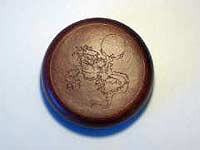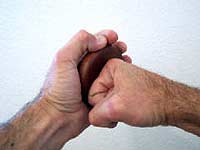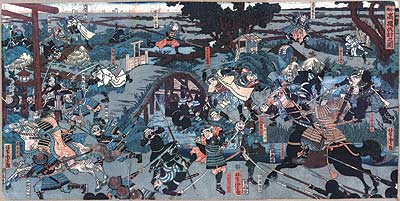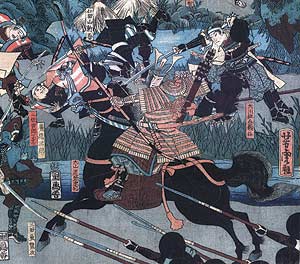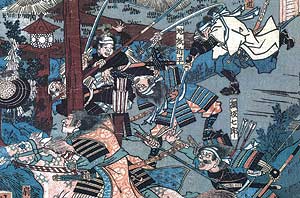|
| Hand Held Makiwara – |
Monday, January 11, 2010
Makiwara
Karate - "Images In Time"
These are powerful and spirited black and white images that capture moments in the continuum of practice and personal development. They are by Jeff Moriber, a long time Matsubashi-ryu karate-ka and award winning graphic designer, fine artist and print maker. Each image is crisply cut out of linoleum tile and produced with saturated inking.
 | |
| BreakingBreaking takes training, spirit and focus. What appeared at the beginning to be an obstacle is really a spiritual destination, a moment through which to pass among the Kiais and road to spiritual development. |
 | |
| KumetePre-arranged Kumete showed me symmetry, control and a key karate principle: to develop the strength and ability to focus power, and the control to not use it. |
 | |
| Low BlockSinking low on one foot with a sweeping lower block while coiling power, beauty and grace combined with cat-like energy ready to spring. |
 | |
| Reinforced BlockAt first it was a little bit like the kid's game of patting your head and rubbing your belly at the same time. How could she do that with such grace, ease, speed and strength? The answer came only a few short training years later: practice. |
 | |
| The StretchShe could just as easily have been a ballet dancer stretching at the bar preparing to practice her craft instead of a fellow karate student stretching before class, both striving for grace and control. Both are beautiful in their own right. |
 | |
| BeltI always treated each of my belts, white, green, brown and now black, with great respect. Each is imbued with countless hours of training. Each was almost always saturated in sweat, daily. Frayed at the edges from repeated knot tying and wearing. Yet always reminding me of the balance to be strived for in life. The belt shows me, when I roll it up to put it away after training, or put it on to train, that symbol, yin-yang, is always at its center. |
Sunday, January 3, 2010
The Shocking Truth About Stun Guns
If you are outside the world of law enforcement, chances are you haven't had much "hands on" work with stun guns. Stun guns are as popular today as they have ever been and with the newer smaller packages like cell phone/stun guns, their popularity continues to grow. But before you deploy a stun gun, there are a few misconceptions you may not know about.
1. All stun guns are created equal. Not true. Don't waste your time with anything under 300,000 volts. It will lack the impact that you need to get any affect on your target. Plus the chances of penetrating thick clothing are slim. Unfortunately, most popular size stung guns fall under the 300,000 volt bench mark.
2. All you have to do is touch the attacker anywhere on his body for the stun gun to work. In fact, most directions will tell you to attack the extremities of your assailant. In order to get the result you need you should stun the target in the same areas that you would strike them. Neck, face, genitals, inner thighs. These targets will give you the maximum effect you want.
3. The stun gun will work instantly. False. You will need to hold the stun gun on the target and drive it into the surface for, in some cases, several seconds. Let me tell you, five seconds will be an eternity. Prepare yourself now for what will happen.
4. The attacker will be incapacitated. Remember Rodney King? Not every one will fall over even if they're shocked for an extended period of time. Not all of us are created equal. Some have different pain thresholds, may be under the influence or may be a emotionally disturbed person (EDP). You never know. So plan for the worst and hope for the best. But never expect ANYTHING you do to end the fight.
Should you throw your stun gun away? No way, but know that it is just a tool to help you survive. When a criminal sees the stun gun and even hears it, he may just start jumping around like his pants are on fire with out you even touching him. Great, knock him out or escape- the stung gun did its job. Look at pepper spray, stun guns, personal alarms are all excellent tools, but don't expect them to take the assailant out. Expect the minimum. They will afford you a distraction that will allow you to inflict more damage on the target or escape.
The problem is that people, especially in law enforcement, become too dependent on these tools. They are just that, tools to make your task easier. The majority of the time, a shot of pepper spray or a taser will do the job. Personally, I want to go home all of the time, not a majority of the time. But its up to you, do you want to be alive 70% of the time of 99% of the time. I don't know about you but you're not keeping me away from my family, no matter who you are. I am going to bite, kick, scrape and use any and everything to get me home to my family. How about you? What did you do today that will make you stay alive? Nothing, I'm already training.
Everyday, on my way to the office, I am training my grip. Every opportunity I can, I train.
Picture your enemy, in prison, on the corner, wherever. Put a face to him. When wresting legend Dan Gable used to train, he would picture his opponent practicing. He would get up in the middle of the night and do calisthenics because he was certain his opponent was sleeping. When Judo Kimura heard that his opponents trained 3 hours a day, he trained 6. When they went to 6, he trained for 9. It's up to you, but training is a habit, just like anything else. It starts small and then grows. Pick up the heavier load. Walk the long way around, take the stairs- it's a start.
I'll ask you again "What did you do today?" Like Vince Lombardi said, "Winning is not a sometime thing; it's an all the time thing. You don't win once in a while; you don't do things right once in a while; you do them right all the time. Winning is a habit. Unfortunately, so is losing. There is no room for second place. There is only one place in my game, and that's first place."
The only place for you is first place- Surviving.
but what the heck- it's all about training.
Basic Drills
We all have a good foundation in the basic blows and combinations.
Think about adding the following drills to your basic syllabus.
These can be trained as "stand alone" combinations OR worked into existing "Defendu" combinations either "before" or "after".
1. HARD left lead to chin (mental foramen) HARD overhand right to chin (opposite side) then: HARD upward right knee to fork.
Repeat punching combo. Then: Side step with right leg (out and to the right 45 degree) LEFT knee to fork.
2. HARD left to chin. HARD right to solar-plexus.
Then the knee smashes as above.
3. HARD left to SOLAR-PLEXUS. HARD right to chin.
Then the knee smashes as above.
4. HARD left to solar-plexus. HARD right to SOLAR-PLEXUS.
Then the knee smashes as above.
Basically it's a series of drills to train the TWO most fundamental punches to head and body, followed by a knee smash to the nuts, practicing with either knee.
Give it a try.
NO BITCHING about "hurting" your hands! NO "Nancy" boys (or girls) allowed here!
________________________________________
Now try this:
For the sake of the drill "visualize" an attacker moving in with a straight left lead right to your snot-box.
What realistic possibilities exist:
1. Side step IN to your LEFT and 45 degrees.
2. Side step DIRECTLY to YOUR left.
3. Side step BACK to LEFT at 45 degrees.
4. STEP directly to the REAR.
Any of these FOUR "inside" shifts/footwork maneuvers will allow you to avoid/evade the straight left and COUNTER from the OPEN or INSIDE line (his right/your left).
EACH of these sidestep/back step maneuvers HAS both advantages and disadvantages. Depending on environment-obstacles and/or multiple assailants, etc. EACH can be useful if NOT the only choice possible. FIGURE THIS OUT!
Now add the FOUR basic combinations. You NOW have TWENTY-FOUR drills to use and abuse. TWO HARD PUNCHES - A KNEE or KICK to the NUTS and FOUR footwork maneuvers and YOU have enough material to LAST FOR MONTHS or daily training.
AND THIS is only for YOUR LEFT SIDE!
SOOOOOOOOOO.........How do we train this and REALLY LEARN from it:
Face your main striking tool (Bob, Spar Pro, Heavy bag). VISUALIZE the STRAIGHT LEFT LEAD and THE BODY POSITION of your IMAGINARY attacker. The bag now becomes THAT assailant - Left hand snaking out to crush your - LEFT foot forward, BODY turned to a 45 degree.
OK? Get IT?
NOW practice sidestepping as above and then IMMEDIATELY countering. EACH FOOTWORK pattern will allow you (or FORCE you) to make adjustments in order to close in and HIT with POWER, speed, accuracy and BALANCE. WORK THIS!!!!!!!! Your common sense and BODY will TEACH YOU THE BEST WAY to do THIS!
NEXT...........................Place an OBSTACLE like a chair at various points to YOUR left or the bags right. This represents either a REAL obstacle OR a SECOND adversary.
NOW, figure OUT which BODY maneuver will GET YOU OUT of DODGE and still ALLOW for a HARD and FAST while GIVING the "second" opponent the LEAST chance of successfully attacking OR how you would have to move to AVOID a REAL WORLD obstacle.
And this is JUST the beginning! Imagine how GOOD you will become if you TRAIN EACH INDIVIDUAL technique like this!
Make a COMPLETE study of a KNEE smash, edge of hand, chin-jab, tiger-claw, side boot kick, groin kick, elbows, punches, and on and on! Master each INDIVDUAL attack covering ALL OPTIONS both left and right sides and LEFT and RIGHT body shifting!
THEN start with combinations!
Just think of the SKILL, SPEED, POWER and MASTERY you will acquire over EACH attack method, and THEN consider how well you'll move with your combinations!
This is what we worked on yesterday at Ralph's.
Like I always say...............YOU are YOUR BEST TEACHER!
Get something REALLY GOOD to HIT. Attach a rope or belt or anything that you can SEIZE HARD and YANK with your left hand. Now take your right fist and PUNCH AS HARD, AS FAST, AS POWERFULLY as YOU CAN REPEATEDLY. FASTER and HARDER. WITH AS MUCH INTENSE EMOTION, ANGER, RAGE, HATE, FURY, VENOM, FEROCITY and KILLING INSTINCT as you CAN!
A Beginning History of Old School Jujutsu
Over the next couple of day's I will writing an article of the history of Pre-WWII Japanese Jujitsu/Judo. I wasn't sure where to start, but here I am so let's get started.
I'm going to start with H. Irving Hancock, who in the early 1900's wrote several books on the history of Japanese physical training & Jujitsu. I will start with his book Japanese Physical Training written in 1903.
"Subsequently he studied in Nagasaki, under Inouye San, instructor of Jiu-jitsu in the police department of that city".
This was the first time I heard of Inouye. Now if we look at Hancock's other book Jiu-jitsu Combat Tricks written a year later in 1904:
"Exponents of the Tenjin School of jiu-jitsu have developed in all its possible perfection a style of stopping the boxer's blow that cannot be surpassed for neatness of execution, effectiveness and swiftness. It is a feat that applies only to stopping a left-hand blow by the boxer."
Before leaving this book, the reason for the above two quotes are:
1.) The mentioning of Inouye, the jujitsu instructor of the Nagasaki police dept.
2.) The mention of the system "Tenjin/Tenshin"
Later you will see where I'm going with this.
Another quote that is very interesting.
"In Japan the full course in jiu-jitsu requires four years time".
That seems very reasonable, as I have read that it takes about 15 years to receive a Menkyo Kaiden in Tenjin Shinyo Ryu today. The question is, why so long? I don't have 15 years to devote to one art.
At this point I would like to bring up another old book on jiu-jitsu, "THE YABE SCHOOL OF JIU JITSU" written in 1904 by Yae Kichi Yabe. In Yabe's book he mentions that the system is based on that of "Tenshin". Also in this book is the phase "Vital Touches" used to describe Atemi or "Ate"!
Professor John J. O'Brien states that he received his diploma in Jiu Jitsu in 1905 from the Governor of Nagasaki. O'Brien spent ten years as Inspector of Police in Nagasaki. He was responsible for introducing Presiedent Teddy Roosevelt to Jiu Jitsu as well as instructing Colonel A.J. Drexel Biddle.
Next we move on to Col. Risher W. Thornberry. Thornberry wrote several books on jujitsu from 1905 to 1933. In his first jujitsu book written in 1905, the first page is very interesting. It shows a picture of Prof. Kishoku Inouye, "Instructor to the Nagasaki Police". At the top of the page it reads, "Jiu-jitsu - As taught by Prof. Inouye to over 2,000 Officers and Soldiers now at the front line." Reference to the Russo/Japanese war.
This book was written only a year or two after Hancock's book. They both mention Inouye & Tenshin. A definite connection is beginning to develop.
An interesting quote from Thornberry's book,
"Jiu-jitsu has a weapon in the form of "atemi, or vital touches", which may be administered with the thumb, the clenched hand, the elbows, the tows, the edge of the hand, or even with the head." Again, the reason for mentioning this quote is the use of the word "Vital touches".
Research shows that Thornberry actively taught jiu-jitsu. One of Thornberry's students was Samuel R. Linck. Linck went on to publish a book in 1943 called "COMBAT JIU JITSU". An excellent book. Linck studied under Thornberry in Los Angeles for a number of years. Linck received a "Master Diploma" from Thornberry in "Tenshin Ryu" dated May 6th, 1935.
In Linck's book he offers a brief history of jiu-jitsu.
"These forms of the art were closely guarded and only taught to the samurai or warrior class, the group now known as the Black Dragon Society".
Linck taught a man by the name George Tate. Linck and Tate taught a jiu-jitsu class in Los Angeles. Later on, Tate succeeded Linck as instructor and continued to teach and train in Jiu-jitsu. Tate went on to become the jiu-jitsu instructor for the Los Angeles police department and later conducted class at the L.A. Judo Club.
Bogu Training
About four years ago Carl recommended we start using the Bogu during our kumite (sparring practice). This method was developed in Okinawa and then found its way into mainland Japan and eventually to the U.S. where only a few clubs still do this. And even in those clubs, only a few members do it. I know there is other equipment out there that looks similar and I have used most of what's available. But it does not provide you with nearly the same overall effect that the bogu does. Rules in bogu training - Any punch, any kick, save foot stomps, a strike to the spine and to the back of the neck. Throws and leg kicking is certainly allowed. Use, dare I say, your commonsense.
What is the training like?
When you fight, you just go and beat the crap out of each other. This is the point. Sure, you look to get that "One Shot One Kill" but you have to train in a way that prepares you for reality. If you train to stop after that first shot- you are developing a habit that will come back to haunt you. You always train three techniques ahead.
Immediately, you will find out what works and what doesn't work. Depending on the drill, sometimes we do rounds, sometimes 10 second bursts. There's a little stalking- but when you go, it's like two freight trains smashing into one another. You hit, you get hit, you lock up, you knee and you throw- great stuff. One of the first things you will notice is that when you punch or kick the hard surfaces of the bogu- it hurts. A body will feel like a feather bed compared to a bogu. But, after a while- it doesn't hurt. Then you can start really throwing some lead!
You will also see what strikes have an effect and which ones do not. If you can back a guy up with the bogu on or ring his bell a bit- chances are it's a good shot. If you graze him, he keeps coming and you have to keep fighting.
The bogu also teaches you to keep fighting! Lesser equipment will cause you to slow down and stop when things get critical. Or stop when one person scores the point. Scoring a point does not mean the fight has ended. It's only a symbolic representation of it. It's not literal.
Wearing the bogu allows you to take punishment without being seriously hurt- save the fat lip, sore legs, fingers, toes or sore jaw. You will get used to the shock of being hit. This will enable you to operate in that harsh environment of combat and it will allow you to absorb as much damage as possible. I have seen people develop other things that allow you to feel nothing. This isn't really good either. It takes away the risk factor and all you have is two supermen running into one another with out any fear of pain. Plus it takes away the body conditioning element. As always, exercise caution and work at a level you can handle. When starting with people who haven't done it before- take it a little easy so they can get used to it. After a couple times- then you can blast 'em.
The MEN (Head Piece) of the bogu is extremely claustrophobic. This is an excellent way of replicating the effect of tunnel vision and frustration you feel when you are the hormonal stress of combat. Don't talk to me about something for MACHO or even Shureido- unless it's got the grill, it ain't cutting it.
The head piece also provides neck and chin protection that modern head-gear do not. Again, the chest protector is HARD. This is important to develop power and condition your weapons.
Can you tell who wins and who loses? Well if the guy quits you win. If you quit, you loose. But that's not the point. IT'S THE TRAINING. It's the befit of fighting like this that you want; the overall training effect NOT winning a game. Sure there are tournament rules, but that will force you to stop when you should be fighting!! It's the feeling of the fight, the punishment and the impact that counts. It's dealing with the confines of the bogu. Just the simple fact that your training partner no longer has a face and is replaced by this samurai from hell is worth the price of admission.
Is it cheap, no- but do you value good training or do you want to used that foamed dipped crap. It's up to you. This stuff will last you a life time. If you can sucker I mean convince some people to invest- take the plunge. Go to http://www.bogubag.com/Bogu/Karate_Bogu/karate_bogu.html. Get the traditional "Do" and "Tare", a set of grappling gloves a good cup, knee pads, the good old white, cheap shin and instep pads and a hachi maki or a bandanna. You don't need a mouth piece- the bogu will keep you mouth shut. I don't think Bogu bag knows I am recommending the link- but, it's good stuff.
